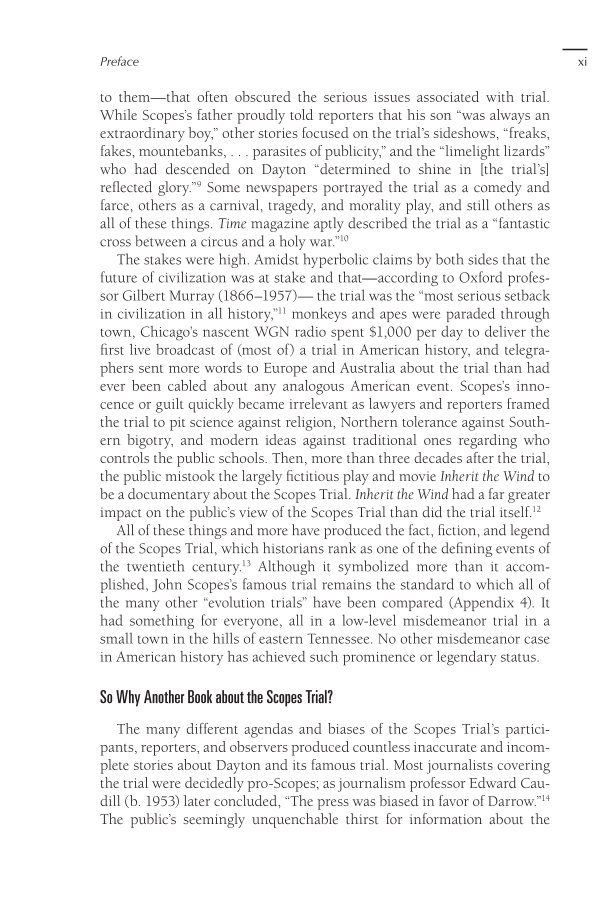Preface xi to them—that often obscured the serious issues associated with trial. While Scopes’s father proudly told reporters that his son “was always an extraordinary boy,” other stories focused on the trial’s sideshows, “freaks, fakes, mountebanks, . . . parasites of publicity,” and the “limelight lizards” who had descended on Dayton “determined to shine in [the trial’s] reflected glory.”9 Some newspapers portrayed the trial as a comedy and farce, others as a carnival, tragedy, and morality play, and still others as all of these things. Time magazine aptly described the trial as a “fantastic cross between a circus and a holy war.”10 The stakes were high. Amidst hyperbolic claims by both sides that the future of civilization was at stake and that—according to Oxford profes- sor Gilbert Murray (1866–1957)— the trial was the “most serious setback in civilization in all history,”11 monkeys and apes were paraded through town, Chicago’s nascent WGN radio spent $1,000 per day to deliver the first live broadcast of (most of) a trial in American history, and telegra- phers sent more words to Europe and Australia about the trial than had ever been cabled about any analogous American event. Scopes’s inno- cence or guilt quickly became irrelevant as lawyers and reporters framed the trial to pit science against religion, Northern tolerance against South- ern bigotry, and modern ideas against traditional ones regarding who controls the public schools. Then, more than three decades after the trial, the public mistook the largely fictitious play and movie Inherit the Wind to be a documentary about the Scopes Trial. Inherit the Wind had a far greater impact on the public’s view of the Scopes Trial than did the trial itself.12 All of these things and more have produced the fact, fiction, and legend of the Scopes Trial, which historians rank as one of the defining events of the twentieth century.13 Although it symbolized more than it accom- plished, John Scopes’s famous trial remains the standard to which all of the many other “evolution trials” have been compared (Appendix 4). It had something for everyone, all in a low-level misdemeanor trial in a small town in the hills of eastern Tennessee. No other misdemeanor case in American history has achieved such prominence or legendary status. So Why Another Book about the Scopes Trial? The many different agendas and biases of the Scopes Trial’s partici- pants, reporters, and observers produced countless inaccurate and incom- plete stories about Dayton and its famous trial. Most journalists covering the trial were decidedly pro-Scopes as journalism professor Edward Cau- dill (b. 1953) later concluded, “The press was biased in favor of Darrow.”14 The public’s seemingly unquenchable thirst for information about the
Document Details My Account Print multiple pages
Print
You have printed 0 times in the last 24 hours.
Your print count will reset on at .
You may print 0 more time(s) before then.
You may print a maximum of 0 pages at a time.

























































































































































































































































































































